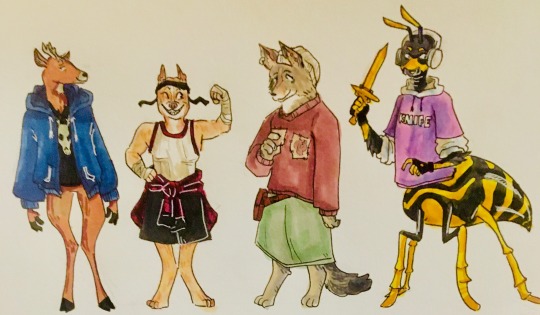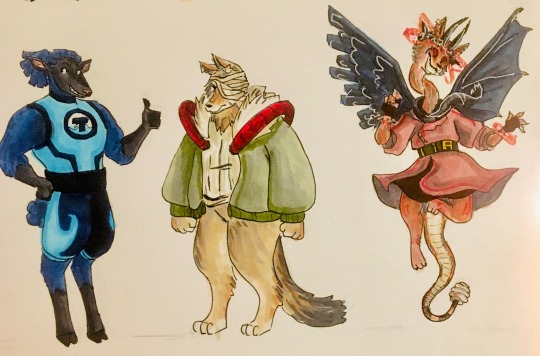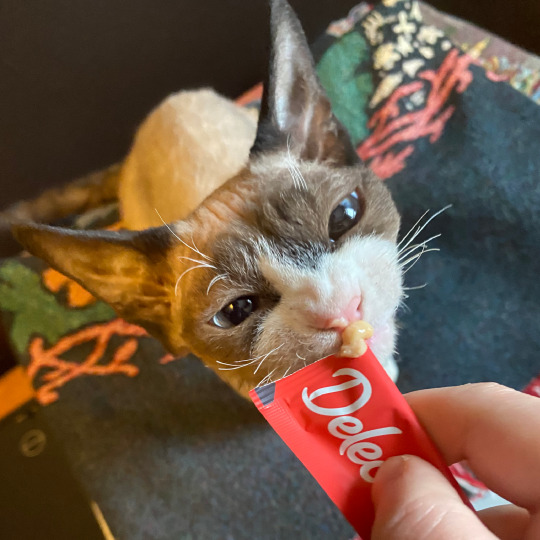#disease.
Explore tagged Tumblr posts
Text


spent the last 2 days thinking about what animals pd characters would be :3
#my post#my art#jrwi pd#prime defenders#fanart#yey <3#i have Reasons for everyones animal#wiwi is a deer bcus like. deer in headlights. prey animal. hes so scared literally all of the time. also made me think of chronic wasting#disease.#dakota is a dog because of course he is. no explanation needed. but hes specificially a pitbull bcus people look at him and think hes a bad#kid yknow. hes failing school he trespasses up the sides of buildings hes always late. idk something about how people think pitbulls are#inherently bad dogs.#also they have the biggest goofiest smiles and thatz so dakota to me#ashe is a coyote bcus i Needed him to be a social animal. and fun fact- coyotes dont live in packs but they live in family groups!#vyncent is a wasp (not because of Revenge of the Wasps but that was a funny coincedence)#because i needed a way to make him still visibly seperate from the prime people. so i made him a bug rather than a mammal.#hes a wasp bcus yknow workers drones hive mind. vyncent struggles with his identity. with taking action. with knowing who he is and what he#wants. hes a follower. chose wasp specifically mostly bcus a) yellow and he has yellow magic#and b) bcus they can sting a lot. and hes knife!#tide is a sheep bcus hes a clone. yknow. like dolly the sheep!#also a bit bcus like sheep get herded around and tide thinks being a hero is about following orders (at least in s1 he does lol)#mark is also a coyote bcus like ashe is one. but alsooo coyotes are opportunistic. will work with whoever to hunt. and well you know mark.#he did what he had to do.#they also go off on their own away from their family group to hunt! and mark left ashe alone to go work. yaaaay#and the trickster!!! i kindof randomly chose 5 animals (1 for each of the array) based on spookiness#so theres a rattle snake (tail) a raven (wing) a bat (other wing) an owl (neck) and a geep (goat/sheep. horns)#i thought itd be fun if it could twist its head all the way around all freaky style :]#also this is cursed as fuck but overlords whole thing was turning people into animals right. would this make his thing in this au be making#animals into people?? thats horrifying#and also why i drew mark w the bandages bcus i wasnt sure whether to make him half lizard still or. part human.
58 notes
·
View notes
Note
what is up with bellaya

5 notes
·
View notes
Text
@airlocksandaviaries
Cute partner nicknames
The One
gay sex
Manhattan project
disease
32K notes
·
View notes
Text

🐊🐊🐊🐊🐊
#my art#digital art#digital painting#doechii#idek if i like this anymore but whtever spent too long to not post#lowkey i like the car in the bg more i have over-working disease when it comes to digital painting#and ive looked at jt too long i cant perceive it anymore#id in alt text#artists on tumblr
59K notes
·
View notes
Text
cannot stop thinking about the french man who during dinner responded to a person asking "should we be naughty and get desert" by pulling a face and going "naughty? it is chocolate, it is not an, uh, threesome"
#more beautiful quotes from the beautiful man include#'sorry for crying talking about getting fucked in the ass makes me so...how you say....nostalgic'#and#'i am so sad you have diseases i want to exchange blood. with you“#t'adore that fucker
56K notes
·
View notes
Text
Some people don’t want to hear this but sometimes accessibility is not sustainable or eco-friendly. Disabled people sometimes need straws, or pre-made meals in plastic containers, or single-use items. Just because you can work with your foods in their least processed and packaged form doesn’t mean everyone else can.
#chronic fatigue#chronic illness#chronic pain#chronically ill#disability#disabled#fibromyalgia#lupus#autoimmine disease#pots#pots syndrome#invisible illness#invisible disability#accessibility#cripple punk
40K notes
·
View notes
Text
what is it with able bodied people saying “get well soon” after you say that you’re chronically ill?? like? i am not gonna? and i once literally responded with “i’m not gonna, it’s chronic, as in permanent.” and they went like “oh well, hope you get better!” like bro 💀
#chronic disability#chronic illness#chronically ill#chronicpain#chronic disease#disabled#chronic fatigue#chronic pain#disability#disabilties
44K notes
·
View notes
Text
I feel like if Hanahaki disease was real in the House MD universe there’d be a whole episode about them treating a patient with it and they like lie or some shit about not telling so and so about their love or like the person they love is dead or something and so they try to cure them another way and the whole time House is like being a dick as always and making fun of them for it and like haha you won’t tell them you love them loser and then at the end of the episode the person the patient loves comes in at the last minute when the patient is on the brink of death and they confess and so the patient lives and gets a happy ending but then Wilson talks to House and says something like “the lengths people would go to to avoid rejection” and House would respond like “yeah these idiots would risk their lives just to not get their stupid feelings hurt” and then Wilson leaves and literally right after he’s gone House coughs up a few petals and barely reacts and just throws them into the trash or a fireplace or something and walks out into the hallway and the episode ends and it’s literally never brought up again
#hanahaki#hanahaki disease#house md#hate crimes md#hilson#gregory house#james wilson#dr house#dr Wilson#dr james wilson#dr gregory house#greg house#hatecrimes md
13K notes
·
View notes
Text
I don't think my body realizes how healthy my labs say I am
#chronic life#chronic disease#chronic illness#autoimmune#chronicillness#chronicillnesshumor#spoonie#spoonie humor#autoimmine disease
12K notes
·
View notes
Text
I've been disabled for almost 29 years. Here's what I've learned.
Tablets sink and capsules float. Separate out your tablets and capsules when you go to take them. Tip your head down when taking capsules and up when taking tablets. Liquigels don't matter, they kinda stay in the middle of whatever liquid is in your mouth.
If your pill tastes bad, coat it with a bit of butter or margarine. I learned this from my mom, who learned it from a pharmacist.
Being in pain every day isn't normal. Average people experience pain during exceptional moments, like when they stub their toe or jam their finger in a door, not when they sit cross-legged.
Make a medical binder. Make multiple medical binders. I have a small one that comes with me to appointments and two big ones that stay at home, one with old stuff and one with more recent stuff.
Find your icons. Some of mine include Daya Betty (drag queen with diabetes), Stef Sanjati (influencer with Waardenburg syndrome and ADHD), and Hank Green (guy with ulcerative colitis who... does a bunch of stuff). They don't have to be disabled in the same way as you. They don't even have to be real people. Put their pictures up somewhere if you want; I've been meaning to decorate my medical binders with pictures of my icons.
Take a bin, box, bag, basket, whatever and fill it with items to cope with. This can be stuff for mentally coping like colouring books or play clay or stuff for physically coping like pain medicine or physio tape.
Decorate your shit! My cane for at home has a plushie backpack clip hanging from the end of the handle and my cane for going places is covered in stickers. All of my medical binders have fun scrapbooking paper on the outside. Sometimes, I put stickers and washi tape on my inhalers and pill bottles. I used my Cricut to decorate my coping bin with quotes from my icons, like "I've seen enough of Ba Sing Se" and "I need you to be angrier with that bell".
If a flare-up is making you unable to eat or keep food down, consider going to the ER. A pharmacist once told me that since my eye flares can make me so nauseous that I cannot eat, then I need to go to the hospital when that happens.
Cola works wonders for nausea. I have mini cans of Diet Pepsi in my coping bin.
Shortbread is one of the only things I can eat when nauseous. Giant Tiger sells individually-wrapped servings of shortbread around Christmas or the British import store sells them year-round. I also keep these in my coping bin.
Unless it violates a pain contract or something, don't be afraid to go behind your doctor's back to get something they are refusing you. I got my cardiologist referral by getting in with a different NP at my primary care clinic than who I usually saw. I switched from Seroquel to Abilify by visiting a walk-in.
If you have a condition affecting your abdomen in some way (GI issues, reproductive problems, y'know) then invest in track pants that are too big. I bought some for my laparoscopy over a year ago and they've been handy for pelvic pain days, too. I've also heard loose pants are good for after colonoscopies.
Do whatever works, even if it's weird. I've sat on the floor of the Eaton Centre to take my pills. I've shoved heating pads down my front waistband to reach my uterus.
High-top Converse are good for weak ankles. I almost exclusively wear them.
You can reuse your pill bottles for stuff. I use my jumbo ones to store makeup sponges and my long skinny ones to hold a travel-size amount of Q-Tips.
Just because your diagnostics come back with nothing, it doesn't mean nothing is wrong. Maybe you were checking the wrong thing, or the diagnostic tool wasn't sensitive enough. I have bradycardia episodes even though multiple cardiac tests caught nothing. I probably have endometriosis even though my gynecologist didn't see anything.
You can bring your comfort item to appointments, and it's generally a green flag when someone talks to you about it. I brought a Squishmallow turkey (named Ulana) to my laparoscopy and they had her wearing my mask when I woke up. I brought a Build-A-Bear cat (named Blinx) to another procedure and a nurse told me that everyone in the hall on the way to the procedure room saw him and were talking about how cute he was. Both of those ended up being positive experiences and every person who talked to me about my plushies was nice to me. If you don't feel comfortable having it visible to your provider during the appointment, you can hide it in your bag and just know it's there, or if you're in a video appointment, you can hold it below frame in your lap.
Get a small bucket, fill it with stuff, and stick it in your bed (if you have room for it). I filled a bucket with Ensure, juice boxes, oatmeal bars, lotion, my rescue inhaler, etc. in October 2023 in anticipation of my laparoscopy and I still have it in my bed as of January 2025.
If your disability impacts your impulse control (e.g. ADHD, bipolar disorder), you should consider setting limits around your spending -- no more than X dollars at a time, nothing online unless it's absolutely necessary, and so on. Or, run these purchases by someone you trust before committing to them; I use my BFF groupchat to help talk sense into myself when I buy stuff.
Feel free to add on what you've learned about disability!
12K notes
·
View notes
Text
THIS!!
THIS IS AN AMAZING WAY TO THINK OF CHRONIC PAIN
86K notes
·
View notes
Text
A disease often thought to only affect 18th century sailors is reemerging in Canada.
Earlier this week, doctors identified 27 cases of scurvy caused by prolonged and severe vitamin C deficiency in northern Saskatchewan. Experts say the confirmed diagnoses highlight a broader issue with poverty and food insecurity in rural and remote communities across the country.
Continue reading
Tagging: @newsfromstolenland
11K notes
·
View notes
Text

I have nothing to add. Pure evil.
#us postal service#justice department#george floyd#center for disease control#trump administration#donald trump#us politics#fuck maga#maga morons
6K notes
·
View notes
Text
Say it with me! Wheelchairs aren’t sad! Mobility aids aren’t sad! Mobility aids are instruments of freedom!
#chronically ill#chronic illness#chronic pain#disability#disabled#chronic fatigue#autoimmine disease#mobility aid#cripple punk
38K notes
·
View notes
Text




HAPPY 1st BIRTHDAY!!! I wasn't sure Belphie would make it to adulthood, but look at him now!
#belphegor#he is SO SMALL and SO KITTEN PROPORTIONED#but that's what happens when you spend your kittenhood fighting a disease instead of growing
7K notes
·
View notes